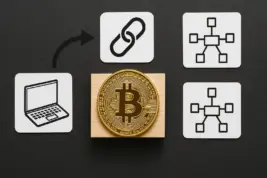Bitcoin Scalability: L2 Architectures, Drivechains, and Decentralization Trade-Offs
Bitcoin’s Scalability: The Trade-Offs in Layer 2, Covenants, and Decentralization
Don’t panic! Despite the buzzwords, scaling Bitcoin is less about rocket science and more about smart architectural plumbing. We’re just trying to fit a global bank through a very secure, tiny mail slot.
Bitcoin’s scalability challenge has sparked debates among developers, investors, and enthusiasts for over a decade. While its Layer 1 remains the most secure and decentralized blockchain network, it cannot match the transaction throughput of traditional financial systems. This limitation raises a core question: how can Bitcoin handle global adoption without compromising its core principles? Layer 2 solutions, rollups, sidechains, and drivechains have emerged to address this problem.

Crucially, each solution introduces unique trade-offs between efficiency, decentralization, and security. Understanding these architectural choices is essential for anyone serious about Bitcoin’s future.
The Core Problem: Why Layer 1 is Not Enough
Bitcoin’s Layer 1 operates on the UTXO model, which ensures transparency and immutability but imposes strict limits on transaction throughput. Even with innovations like SegWit and Taproot, the network struggles to scale under high demand. Some argue that Layer 1 alone may never achieve global transaction levels. However, supporters emphasize that the security and decentralization it provides are unmatched. The challenge lies in finding complementary solutions that can extend capacity without sacrificing trustlessness.
Bitcoin UTXO Set Analysis
The UTXO set represents every unspent output in the Bitcoin network, and it grows as adoption increases. Full nodes must store and validate this data, which can become resource-intensive over time. Pruning techniques help manage size but introduce new complexities. While critics sometimes worry that UTXO growth could threaten decentralization, improvements in node hardware and network protocols, along with strategic pruning, keep the system manageable. This underlines why scaling solutions often turn to Layer 2 rather than attempting to solve everything on Layer 1.
Bitcoin Script Limitations Analysis
Bitcoin Script is deliberately minimalistic to prevent vulnerabilities, but this limits the kinds of on-chain logic that can be executed. Developers seeking complex financial operations must rely on Layer 2 solutions or off-chain constructions. This raises a question: are these constraints a hurdle or a safeguard? In practice, the limitations protect Bitcoin’s security while encouraging innovation through rollups, sidechains, or drivechains. Understanding these constraints is essential for assessing the potential and risks of each scaling approach.
UTXO Commitment Scheme
The UTXO commitment scheme cryptographically ensures that all unspent outputs are accounted for, enabling secure and efficient transaction verification. Without it, nodes would face exponentially increasing workloads. While the growing UTXO set is a concern, a combination of pruning, optimized nodes, and Layer 2 extensions allows the network to scale safely. The commitment scheme remains a cornerstone of Bitcoin’s security while highlighting the need for complementary solutions to achieve higher throughput.
Bitcoin Transaction Throughput Comparison
Transaction throughput is the most tangible indicator of Layer 1’s limitations. Bitcoin processes roughly 3–7 transactions per second, far below traditional payment networks. Even with batching and SegWit, the gap remains significant. Proponents emphasize that **decentralization and security take precedence over raw speed**. Layer 2 networks offer thousands of transactions per second but introduce complexity. Evaluating throughput means balancing performance with trustlessness—a theme that will recur as we examine rollups, sidechains, and drivechains.
Lightning Network: Scaling Payments, Not Computation
The Lightning Network (LN) effectively addresses Bitcoin’s limitations for small, frequent transactions, enabling instant payments with minimal fees. By creating off-chain channels, it drastically improves throughput and reduces congestion on Layer 1. Techniques such as lightning channel jamming mitigation and optimized routing algorithms enhance network reliability and prevent common bottlenecks.

However, Lightning does not solve deeper challenges: liquidity remains unevenly distributed, and complex smart contracts cannot be executed natively. Users may encounter scenarios where funds are trapped in channels or routing failures limit usability. These constraints underscore why complementary solutions are necessary. In summary, Lightning excels at trustless, high-speed **micropayments (off-chain scaling)**, but it is **not designed to execute complex smart contracts or general computation**. Full scalability requires additional architectural layers.
The Battle for Layer 2: Rollups, Sidechains, and Drivechains
Layer 2 solutions provide a pathway to scale Bitcoin without compromising its core security model. Rollups, sidechains, and drivechains each solve different aspects of the scalability problem. The answer to which approach is most effective depends on whether the priority is throughput, decentralization, or ease of implementation.
A key distinction must be made: **Rollups** are considered true Layer 2 solutions because they **cryptographically inherit the security** of Bitcoin’s Layer 1 (L1 enforces the proof rules via mechanisms like BitVM). Conversely, **Sidechains and Drivechains** possess a separate security model. They rely on L1 only for the two-way peg, meaning their transaction validity depends on an independent set of validators (federation or Proof-of-Stake/Work on the sidechain itself), which introduces differing trust assumptions.
Governance Challenges: The Social Side of Bitcoin Scaling
When evaluating L2 solutions, the real battle is often about social consensus. Drivechains, defined in BIP300/301, require modifications to Bitcoin’s Layer 1 consensus rules, demanding widespread agreement from miners, developers, and the broader community. Such changes are politically challenging and can provoke intense debate. In contrast, Rollups—especially BitVM-like approaches—leverage existing Taproot functionality and **do not require a hard fork**. This makes them technically simpler to deploy and socially less controversial. The implication is clear: while Drivechains offer powerful features, their success depends as much on governance and coordination as on code.
Comparative Overview of L2 Architectures
The table below outlines throughput, security models, decentralization, and use cases.
| Feature | Rollups (L2) | Sidechains | Drivechains (BIP300) |
|---|---|---|---|
| Transaction Throughput | High (batch processing) | Moderate (depends on sidechain design) | Moderate-High (Blind Merged Mining) |
| Security Model | Inherits Bitcoin L1 security (optimistic or ZK proofs) | Independent security (requires trust assumptions) | L1-enforced Withdrawal Delay (via Blind Merged Mining) |
| Decentralization Impact | Minimal (security anchored to L1) | Varies (sidechain validators can centralize) | Moderate (L1 miners vote on withdrawal) |
| Settlement Finality | Fast (depends on proof type) | Slower (periodic L1 checkpointing) | Depends on peg and dispute resolution |
| Use Cases | Microtransactions, complex smart contracts | Experimental chains, alt coins, apps | Asset bridging, specific application rollouts |
This comparison clarifies that **no single L2 approach is perfect**. Rollups excel in security and throughput but are technically complex. Sidechains provide flexibility but introduce trust assumptions. Drivechains offer a middle ground with L1 enforcement of the peg, but at the cost of requiring L1 consensus change. These trade-offs illustrate why scaling Bitcoin is not just about speed—it’s about balancing multiple priorities to maintain the network’s integrity and usability. Moreover, adoption matters. Even the most efficient solution will have limited impact without active user participation and developer support. Lightning Network’s gradual growth demonstrates that technical excellence alone is not enough—ecosystem and community engagement are equally crucial. Understanding these dynamics sets the stage for the next critical discussion on Bitcoin Script covenants and OP_VAULT.
The Future of Bitcoin Script: Covenants and OP_VAULT
Bitcoin Script is evolving, and covenants represent one of the most promising extensions for scalability and security. Unlike traditional scripts, covenants allow users to restrict how outputs can be spent in the future, enabling predictable transaction flows. OP_CTV and OP_VAULT provide concrete implementations, each with distinct advantages. OP_CTV offers deterministic transaction templates, improving efficiency for complex contracts, while OP_VAULT emphasizes secure storage and conditional spending. Understanding these tools is crucial for developers designing advanced applications without compromising Bitcoin’s decentralized nature.

OP_CTV vs OP_VAULT Implementation
OP_CTV (CheckTemplateVerify) focuses on standardizing transaction sequences, which reduces verification complexity and opens the door for more scalable Layer 2 protocols. **OP_VAULT**, on the other hand, enforces a **mandatory time-delay (timelock)** on all withdrawals from a secured address. This delay is critical because it gives the user a window to notice an unauthorized transaction and initiate a **recovery path (sweep)** to a safe address, effectively creating a **self-custody anti-theft mechanism**. Both mechanisms can be integrated with Lightning channels, sidechains, or drivechains, but each requires careful planning. Developers should weigh transaction predictability against security needs and choose the tool that aligns with their application goals.
Taproot Covenants Implementation
Taproot has expanded Bitcoin Script capabilities while maintaining privacy and compactness. Covenants implemented with Taproot allow conditional spending that is indistinguishable from standard transactions, which reduces on-chain footprint. This capability is critical for L2 solutions that rely on frequent settlement or automated workflows. The capability to redefine use cases such as recurring payments, vault management, and multi-party contracts is significant. The lesson is clear: **mastering covenants and OP_VAULT is no longer optional for advanced Bitcoin development—it’s essential.**
The Decentralization Cost: Full Node Pruning and Mining Pool Concentration
Scaling Bitcoin involves inevitable trade-offs with decentralization. Full node pruning reduces storage requirements, enabling more participants to run nodes, but pruning limits historical data availability. Meanwhile, mining pool concentration risks centralizing control over block production.
Bitcoin Full Node Pruning Benefits
Pruning allows nodes to discard spent UTXOs while retaining sufficient data to validate new transactions. This reduces hardware requirements, making node operation accessible to a broader audience. As adoption increases, **pruning becomes essential to prevent bottlenecks**. However, it must be paired with mechanisms like L2 solutions or archival nodes to ensure network resilience. For developers and investors, understanding pruning strategies informs decisions on application design and infrastructure planning. Rollups can scale quickly with minimal friction, but may face other limitations in flexibility. Understanding these social and political dimensions is crucial for anyone planning Bitcoin infrastructure deployment or Layer 2 integration.
Mining Pool Centralization Risks
Mining pool centralization can compromise Bitcoin’s decentralization ethos. Large pools controlling a majority of hash power increase the risk of coordinated attacks or undue influence over network upgrades. **Encouraging small, distributed mining operations and monitoring pool dominance are practical steps to mitigate this risk**. While complete decentralization is idealistic, maintaining diversity in mining and node operation ensures robustness against systemic threats.
Comparative Table: Scaling vs Decentralization Trade-Offs
| Aspect | High Throughput Approach | Decentralization Focused Approach |
|---|---|---|
| Transaction Speed | Layer 2 rollups, drivechains, batched settlements | Layer 1 full validation, pruned nodes |
| Security | Depends on L1 enforcement of proofs or sidechain validators | Bitcoin’s L1 consensus (strongest security) |
| Node Requirements | Lower with pruning and L2 reliance | Higher; full historical data retained |
| Flexibility | Supports complex scripts and automated workflows | Limited by standard Bitcoin Script |
| Practical Recommendation | Use for high-frequency applications with L1 fallback | Maintain for long-term network resilience |
Between these approaches, the optimal strategy is often hybrid: leverage L2 for throughput while maintaining a network of full, archival nodes for security and decentralization. This ensures both operational efficiency and resilience. Advising developers, one should never optimize for speed alone—**long-term network health is the real priority**. Covenants, OP_VAULT, and well-distributed mining pools complement this hybrid approach by enhancing both scalability and security.
Conclusion
In conclusion, Bitcoin’s path to scalable, decentralized payments lies in a careful blend of Layer 1 integrity and Layer 2 innovation. Rollups, sidechains, and drivechains provide throughput solutions, while Taproot covenants and OP_VAULT enable sophisticated, secure applications. Pruning strategies and decentralized mining maintain network robustness. For practitioners, the advice is clear: study these mechanisms deeply, apply them judiciously, and always prioritize both efficiency and decentralization. This analytical, structured approach ensures Bitcoin continues to evolve without compromising its foundational principles.
Disclaimer
The strategies and analyses presented here—Layer 2 solutions, Taproot covenants, OP_VAULT, pruning techniques, and decentralized mining considerations—are intended for educational and informational purposes only. They reflect current research, technical proposals, and observed network behavior, but the Bitcoin ecosystem evolves rapidly. Practitioners should independently verify implementation details, assess risks, and remain adaptable to protocol changes, network upgrades, and unforeseen security challenges. This content does not constitute financial, investment, or professional advice. Decisions regarding deployment or investment in Bitcoin infrastructure should be made based on careful due diligence and aligned with individual goals, risk tolerance, and available resources.
